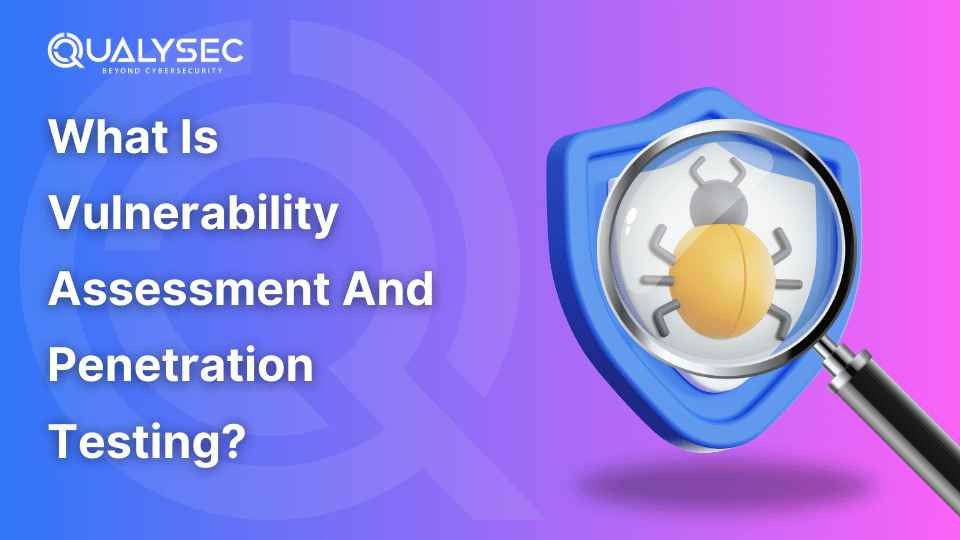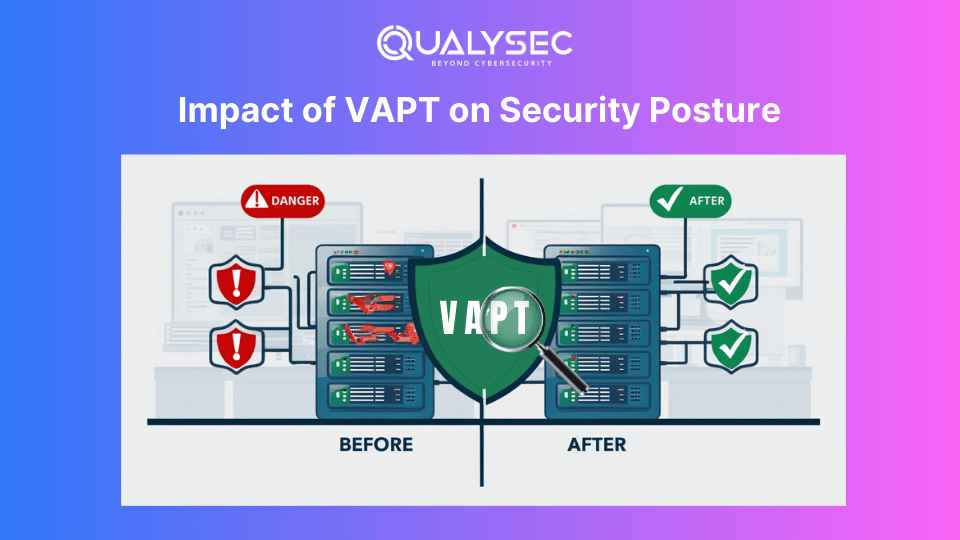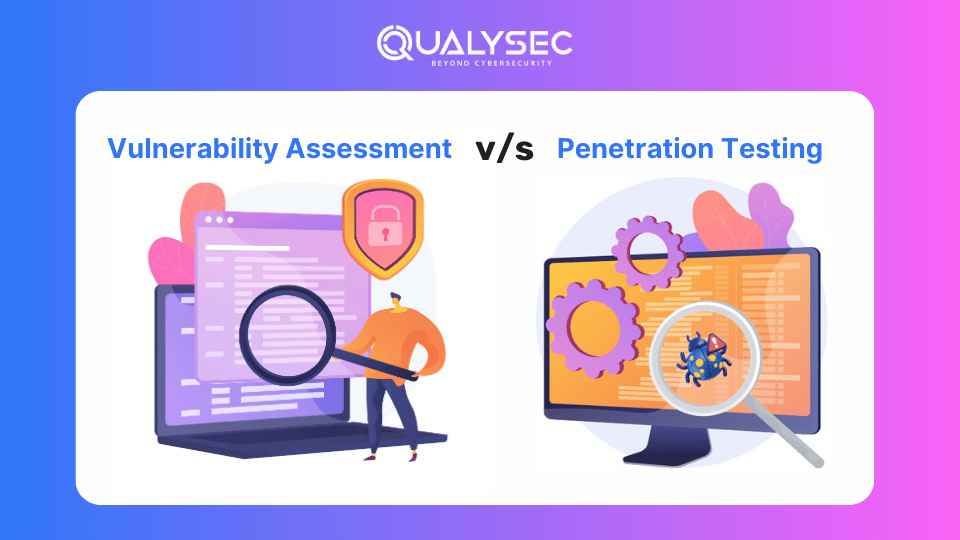
Vulnerability testing comes in two varieties: vulnerability assessment and penetration testing (VAPT). Since each test offers unique advantages, experts often couple them to provide a more comprehensive assessment of vulnerabilities. In a nutshell, penetration testing and vulnerability assessments carry out two distinct jobs within the same field of concentration, typically with contrasting outcomes.
Vulnerability assessment techniques identify vulnerabilities but don’t distinguish between defects that can cause harm and those that cannot. Vulnerability detectors notify businesses of existing vulnerabilities in their code and their locations. To determine whether illicit access or other illegal conduct is feasible and pinpoint which defects provide a risk to the application, penetration tests try to take advantage of a system’s weaknesses.
Penetration tests identify exploitable vulnerabilities and quantify their severity. Instead of identifying every flaw in a system, a penetration test aims to demonstrate how harmful an error could be in an actual attack. When used in combination, penetration testing and vulnerability assessment technologies offer an in-depth understanding of an application’s vulnerabilities and the threats they pose.
While vulnerability assessments identify possible weaknesses, penetration testing aims to take advantage of them by imitating actual attacks. These methods, in spite of their apparent distinctions, represent both halves of an identical face that complement one another to provide a whole study.
In digital networks, computers, apps, and cloud environments, vulnerability assessment is the method of identifying, classifying, and prioritizing security flaws. In order to lower risk, companies can employ it to gain insight into how safe they are and how vulnerable companies are to violence.
Penetration testing is a virtual test that a security professional does to identify vulnerabilities in a computer system or network. Security specialists help companies evaluate their safety record and identify threats for repair by taking advantage of vulnerabilities such as SQL injections, unauthorized entry, escalated rights, or problems with the system.

Vulnerability Assessment and Penetration Testing (VAPT) gives organizations a greater thorough analysis than an individual test only. An organization can better safeguard its systems and data against hostile assaults by using the vulnerability assessment and penetration testing (VAPT) technique, which provides a deeper knowledge of the threats facing its applications. Both internally developed software and apps from outside suppliers may have vulnerabilities, but the majority of them can be readily addressed once they are discovered. Employing newly developed software and apps from outside suppliers may have vulnerabilities, but the majority of them can be readily addressed and categorized. In a VAPT service, IT safety teams get to focus on fixing important vulnerabilities while the VAPT provider continues to identify and categorize problems.
Any kind of compliance, be it the PCI, FISMA, or the other, is an immense task. Businesses can more quickly and efficiently achieve their compliance needs with Qualysec’s solution. Qualysec Technologies protects sensitive information about customers, company infrastructure, and credibility by identifying vulnerabilities that could harm or jeopardize an application. Installing a system to test apps while they are being developed ensures that privacy is included into the software’s code rather than being added after being issued with costly updates.
Qualysec’s software incorporates both vulnerability assessment and penetration testing (VAPT) techniques. This way, Qualysec gives an exhaustive overview of all the defects discovered as well as an evaluation of risk for each one. In addition to identifying code errors, Qualysec also conducts static and dynamic code analysis to identify any missing features that can result in security lapses.
In the case of using programmed login credentials or login details, Qualysec can figure out whether enough protection is being used and whether a piece of software contains any application vulnerabilities. A team of top-notch professionals devised and continuously improved the technique used in Qualysec’s digital scanning strategy, which yields more accurate testing findings.
By reducing negative results, Qualysec frees up developers and security researchers to invest longer in fixing issues instead of wasting time sorting through non-threats.
Qualysec has created a system for automated, immediate testing of app security. Businesses can utilize Qualysec instead of purchasing expensive vulnerability assessment tools, spending time and cash on upgrading them, or instructing programmers and testing staff on its use. Every time a user logs in, they benefit from the most recent modifications and improvements made by the Qualysec platform.

Talk to our Cybersecurity Expert to discuss your specific needs and how we can help your business.
A vulnerability assessment is typically carried out by software that is automated and carefully scans a computer system as well as a system or program for flaws, including evolving and current CVEs. On the other hand, penetration testing is typically more costly and laborious, and it is carried out by a professional hacker as a planned modeled digital attack.
To uncover and examine defects and zero days, it employs several tools and strategies, such as vulnerability assessment results, to obtain illegal accessibility, upgrade advantages, and navigate widely across an organization.
Automated vulnerability assessments improve security by carefully checking your systems, networks, or applications on a daily or weekly basis, based on your requirements. Although complicated scans can take up to 72 hours, the scanner can produce an evaluation in just ten minutes after fast testing the systems and programs against known vulnerabilities.
In contrast, penetration testing puts more emphasis on complexity rather than efficiency. Depending on the size and complexity of the target system, a pentest might take anywhere from fifteen to twenty days to complete, with analysts personally examining your systems and simulating the strategies of actual attackers.
Using databases of known flaws (CVEs), vulnerability assessments provide a quick, high-level evaluation to find typical dangers such as misconfigured systems or out-of-date software. However, devices can miss special flaws in the logic of the system and set off false alerts. Penetration testing takes things one step further by investigating vulnerabilities and their possible effects and then providing repair advice. As a result, even if it requires more time and resources, it gives a more realistic image of the security testing of your system.
In contrast to penetration testing, vulnerability assessment effectively searches for vulnerabilities and classifies them according to their severity, ease of exploitation, prevalence (the degree to which they occur), and CVSS score (a standardized risk rating). By allocating a risk score, this helps in prioritizing the most important vulnerabilities.
This type of activity, known as pentesting, goes beyond risk assessments. It adds practical problem setting, like probability and consequence, while taking into account the same vulnerability criteria as a vulnerability assessment. Even though they may appear less serious on paper, the human factor aids in identifying CVEs that could be readily exploited in your particular setting.
Vulnerability assessments offer informational inventories of the assets that have been examined and CVEs found, a technical dissection of every bug for risk analysis with consequences for compliance, and detailed instructions for patching it.
On the other hand, penetration testing documents provide more than simply a list of vulnerabilities; they also provide evidence of principle, access technique, execution link, evaluation of effect, and customized repair assistance.
By integrating penetration testing and vulnerability assessment, you can achieve:
Vulnerability assessments give businesses complete data about the security flaws in their system. They also provide suggestions for evaluating the hazards related to these vulnerabilities. By understanding their valuables, security flaws, and general risks, companies can decrease the likelihood that hackers will breach their systems and capture their personal information.
Vulnerability assessments assist in promptly identifying vulnerabilities and threats and implementing corrective measures to close any gaps in the infrastructure of the company. To make sure that firms comply with cybersecurity regulations like the HIPAA and PCI DSS standards, vulnerability assessments are also crucial.
To find the weak points in various systems and networks, vulnerability assessments might use a variety of techniques, instruments, and scanning processes. Depending on how easily vulnerabilities in a given system may be found, different types of vulnerability assessments may be used.
All internet-based businesses are at risk due to the sharp rise in ransomware, phishing, and distributed denial of service (DoS) attacks. Due to enterprises’ increased reliance on digital technologies, successful cyberattacks have more effects than ever before.
Penetration testing uses the viewpoint of a hacker to find, stop, and lessen security threats before a malevolent actor may take advantage of them. It assists information technology leadership in putting intelligent security updates into place to reduce the likelihood of an attack succeeding.
To properly defend their assets against penetration assaults, businesses need to be able to update their security measures at the same time. It should be noted that figuring out which techniques to employ or how to employ them in an attack may be challenging. On the other hand, ethical hackers can assist companies in promptly and precisely locating, modifying, and replacing the weak points in their IT infrastructure.

Vulnerability assessment and penetration testing differ in the following key areas:
Compared to penetration tests, vulnerability assessments are more internally focused. They place a strong emphasis on identifying all security flaws in a system and bolstering internal defenses.
Finding weak points in the system from the outside is the main goal of penetration testing, which is more external. To determine the system’s degree of vulnerability to unidentified attacks, external testing is used.
Organizations that use a network with vulnerabilities and wish to find known security issues should use vulnerability assessments. They typically entail an evaluation procedure intended to find every potential security flaw in the system. In addition to routinely evaluating endpoint samples, organizations usually conduct assessments of their whole core resource base.
Organizations who assert that their security measures are robust but wish to ascertain whether their systems are hackable and find the unidentified processes that could expose them to an attack or compromise can benefit from penetration testing. Organizations having a solid security posture will find pentesting particularly helpful in testing their current protections. Pentesting is usually limited to key infrastructure (network firewalls, server infrastructure, and data).
Finding assets in a computer environment is the first step in the vulnerability assessment procedure and methodology. The evaluation team prioritizes vulnerable concerns, rates the danger level of each vulnerability, and finds defects in networks and applications. After that, it offers reports that point out issues and make recommendations for fixes. Reconfiguring the system, patch management, and hardening the security architecture are common steps in vulnerability remediation.
Determining the extent of testing and the degree of exploitation is the first step in the penetration testing process. After finding vulnerabilities, pentesters can evaluate the seriousness of the threats involved. They mimic actual attacks and make use of the vulnerabilities found, inserting agents to grant access to the system for a predetermined amount of time. The testers then conduct a risk analysis to determine the extent of system access that the assault was able to obtain. The pentesting team submits a report following the initial test and analysis that highlights any risks found, evaluates their seriousness, and suggests corrective measures. To make sure the recommended fixes are effective, the pentesters retest the system after the company has implemented the fixes and fixed the vulnerabilities in its security system.
Companies plan vulnerability evaluations on a regular basis, particularly when the impacted networks, systems, and controls undergo continuous changes. Using their business credentials and vulnerability management resources, internal technicians can conduct these assessments to find known risks affecting the networks of internal applications. Additionally, organizations may use outside vendors to manually assess, identify, and examine outcomes.
Penetration can be implemented every year, or organizations can handle specific, significant modifications to their networks, controls, and systems. The tests must be conducted by a qualified, experienced penetration tester (often an outside pentesting service provider). In order to breach secure systems and networks and find vulnerabilities that permit access from outside networks and applications, pentesters are typically skilled ethical hackers.
VAPT is carried out using three different techniques or strategies: gray box, white box, and black box testing. What you need to know about them is as follows:
With a black box penetration test, the tester is unaware of the subject of the test. In this case, from initial access and execution to exploitation, the pen tester carries out an attacker’s strategy without any special permissions.
White box testing is a sort of testing where the tester gets full access to the internal code of the system. In this kind of testing, the tester is aware of what the code is supposed to do. Additionally, it is a technique for evaluating a system’s security by looking at how well it responds to different kinds of real-time attacks.
A gray box penetration test, sometimes referred to as a transparent box test, gives the tester very little information. Usually, login credentials are used for this. One can find out how much access someone with special privileges has and how much damage they can do with the help of gray box testing.
It covers every stage of the testing process:

During the preliminary evaluation phase, the testing team establishes the test’s goals and scope. They work together with the owner or creator of the app to comprehend its objectives, features, and potential risks. This phase entails planning and logistics, including setting guidelines for cooperation, defining the testing environment, and obtaining any authorizations and credentials required to carry out the test.
The testing company recommends starting the testing process with a basic approach. Start by submitting an inquiry through the provided link, which will connect you with experienced cybersecurity experts.
They will guide you through filling out a pre-assessment questionnaire that includes both the technical and non-technical aspects of the mobile application you want to create. In order to clarify the evaluation process, tools, schedule, and anticipated costs, testers set up a virtual presentation meeting.
They then arranged for the signing of a service agreement and nondisclosure agreement (NDA) to guarantee stringent data protection. Penetration testing will start as soon as all required data has been acquired, guaranteeing the security of your mobile application.
During the penetration testing process, the testing team aggressively looks for security holes and vulnerabilities in the mobile application. This stage involves a number of mock attacks and assessments to find weaknesses. The authentication processes, data storage, data transmission, session management, and connectivity to external services of the application or infrastructure can all be rated by testers. A penetration tester may employ source code analysis, dynamic analysis, reverse engineering, manual testing, or automation testing.
Higher ratings indicate a bigger technical and commercial impact with fewer dependencies, and each finding’s severity is evaluated separately.
Probability Determination: The following criteria are used by the assessment team to rate each vulnerability’s potential for being exploited:
Impact Analysis: The team conducting the evaluation investigates and evaluates the exploit’s impact on the firm and its customers in terms of privacy, honesty, and accessibility for each risk that can be adequately attacked.
Severity Ratings: The penetration testing company assigns severity scores based on both internal expertise and generally recognized rating systems, such as the Open Web Application Security Project (OWASP) and the Common Vulnerability Scoring System. Each discovery’s seriousness is assessed separately from the seriousness of the others. More serious vulnerabilities also have a greater technical and business impact and are less dependent on other defects.
The customer will only benefit from the security tester’s findings if they are accurately documented. The following details, although not entirely, should be included in a quality VAPT report for a web application:
Simple explanation:-
The last stage is dealing with the identified vulnerabilities and shortcomings. The mobile app developer or owner implements the report’s recommendations and works on remediation measures to improve the app’s security. This step may also include retesting to ensure that the discovered vulnerabilities are resolved and the app is more secure. The objective is to make the app less vulnerable to security risks while still protecting user data.
The testing team frequently gives a consultation call to ensure that found vulnerabilities are successfully remedied. During this session, the security specialists review the results and offer advice on how to address and resolve the issues. This hands-on support is crucial for your development team to implement the necessary modifications as quickly as possible.
Penetration testing companies provide a letter of attestation as well as a security certificate to ensure the security measures used. These documents confirm that your application has been thoroughly tested and that all relevant security measures are in place.
When it comes to defending digital assets and guaranteeing the highest level of security for your company, look no further than QualySec Technologies. For good reason, QualySec is delighted to be the best VAPT service provider.
Vulnerability assessment and Penetration testing are essential components of a robust cybersecurity strategy. Vulnerability assessments provide a broad picture of potential weaknesses, while penetration testing delves deeper to discover how to overcome such vulnerabilities. VAPT offers a comprehensive plan for identifying, understanding, and reducing cybersecurity threats to assist businesses in maintaining a strong security posture in a dynamic threat landscape.
By implementing routine VAPT, businesses can protect sensitive data, stay in compliance, and build a robust system that can resist potential intrusions.
Ans. Although there are many types, the three primary types of vulnerability assessments include – Web scans that check websites for weaknesses, app scans that focus on software security, and network scans that identify security holes in your computer systems.
Ans. A pentester is a cybersecurity expert who acts like a hacker, ethically attacking systems to find weaknesses. They expose vulnerabilities and attack vectors before real attackers do.
Ans. No, the vulnerability assessment and penetration testing differ. Whereas a vulnerability assessment gives an outline of the weaknesses within a system, penetration testing simulates actual attacks to exploit those.

Pabitra Sahoo is a cybersecurity expert and researcher, specializing in penetration testing. He is also an excellent content creator and has published many informative content based on cybersecurity. His content has been appreciated and shared on various platforms including social media and news forums. He is also an influencer and motivator for following the latest cybersecurity practices.





Plot No:687, Near Basudev Wood Road,
Saheed Nagar, Odisha, India, 751007
No: 72, OJone India, Service Rd, LRDE Layout, Doddanekundi, India,560037
© 2024 Qualysec.com Disclaimer Privacy Policy Terms & Conditions


No: 72, OJone India, Service Rd, LRDE Layout, Doddanekundi, India,560037
© 2024 Qualysec.com Disclaimer Privacy Policy Terms & Conditions